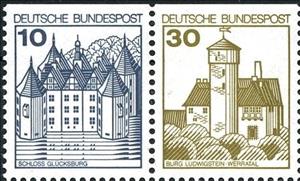Se-tenant: Se-tenant 10pf.+30pf. (Germany, Federal Republic 1990)
Se-tenant 10pf.+30pf. (Germany, Federal Republic 1990)
01 January (Germany, Federal Republic ) within release Strongholds and Castles goes into circulation Se-tenant Se-tenant 10pf.+30pf. face value 40 German pfennig
| Se-tenant Se-tenant 10pf.+30pf. in catalogues | |
|---|---|
| Michel: | Mi: DE W63II |
Se-tenant is square format.
Also in the issue Strongholds and Castles:
- Stamp - Water Castle Inzlingen face value 50;
- Stamp - Water Castle Inzlingen face value 50;
- Stamp - Glücksburg Castle face value 10;
- Stamp - Glücksburg Castle face value 10;
- Stamp - Stronghold Ludwigstein, Werra valley face value 30;
- Stamp - Stronghold Ludwigstein, Werra valley face value 30;
- Booklet - Booklet 22 II "Strongholds and Castles" face value 200;
- Se-tenant - Ludwigstein; Glücksburg face value 30+10;
- Se-tenant - Glücksburg; Inzlingen face value 50+10;
- Se-tenant - Glücksburg; Inzlingen face value 50+10;
- Se-tenant - Glücksburg face value 2*10;
- Se-tenant - Inzlingen face value 2*50;
- Se-tenant - Se-tenant 10pf. + 30pf. + 10pf. face value 10+30+10;
- Se-tenant - Se-tenant 10pf. + 30pf. + 10pf. face value 10+30+10;
- Se-tenant - Se-tenant 30pf. + 10pf. + 50pf. face value 50+30+10;
- Se-tenant - Se-tenant 10pf.+30pf. face value 40;
- Se-tenant - Se-tenant 10pf.+30pf. face value 40;
- Se-tenant - Ludwigstein Castle, Werra valley face value 2*30;
- Se-tenant - Se-tenant 30pf.+10pf.+50pf. face value 90;
- Se-tenant - Se-tenant 30pf.+10pf. face value 40;
Se-tenant Se-tenant 10pf.+30pf. it reflects the thematic directions:
A building or edifice is a structure with a roof and walls standing more or less permanently in one place, such as a house or factory. Buildings come in a variety of sizes, shapes and functions, and have been adapted throughout history for a wide number of factors, from building materials available, to weather conditions, to land prices, ground conditions, specific uses and aesthetic reasons. Buildings serve several needs of society – primarily as shelter from weather, security, living space, privacy, to store belongings, and to comfortably live and work. A building as a shelter represents a physical division of the human habitat (a place of comfort and safety) and the outside (a place that at times may be harsh and harmful).
A castle (from Latin: castellum) is a type of fortified structure built in Europe and the Middle East during the Middle Ages by European nobility. Scholars debate the scope of the word castle, but usually consider it to be the private fortified residence of a lord or noble. This is distinct from a palace, which is not fortified; from a fortress, which was not always a residence for nobility; and from a fortified settlement, which was a public defence – though there are many similarities among these types of construction. Usage of the term has varied over time and has been applied to structures as diverse as hill forts and country houses. Over the approximately 900 years that castles were built, they took on a great many forms with many different features, although some, such as curtain walls and arrowslits, were commonplace.
A fortification (also called a fort, fortress, fastness, or stronghold) is a military construction designed for the defense of territories in warfare, and is used to establish rule in a region during peacetime. The term is derived from Latin fortis ("strong") and facere ("to make").
A palace is a large residence, often serving as a royal residence or the home for a head of state or another high-ranking dignitary, such as a bishop or archbishop. The word is derived from the Latin name palātium, for Palatine Hill in Rome which housed the Imperial residences
A tower is a tall structure, taller than it is wide, often by a significant factor. Towers are distinguished from masts by their lack of guy-wires and are therefore, along with tall buildings, self-supporting structures.




